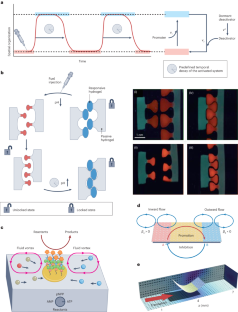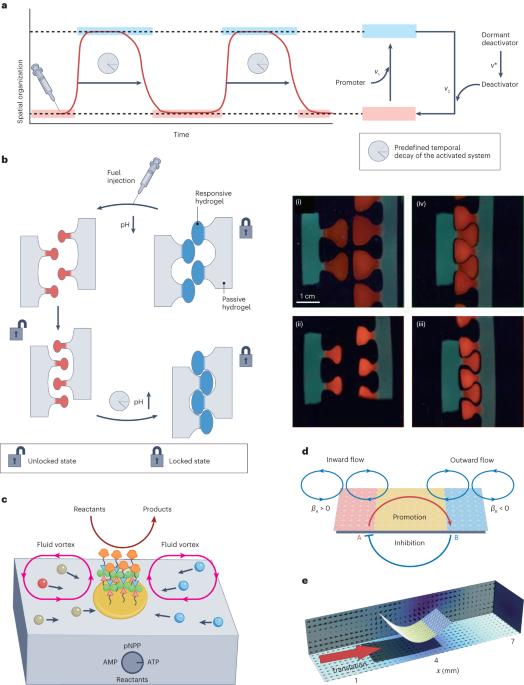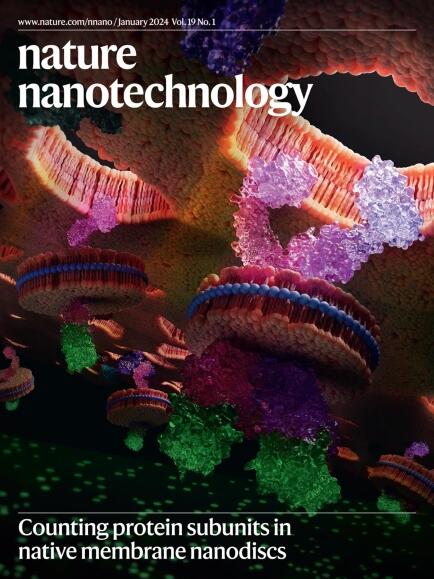耗散材料的空间维度和动力学过程相互联系,创造具有逼真功能的合成系统
IF 34.9
1区 材料科学
Q1 MATERIALS SCIENCE, MULTIDISCIPLINARY
引用次数: 0
摘要
生物系统自发地将能量输入转化为生存所必需的行动。受这些过程的有效性的激励,研究人员的目标是锻造材料系统,表现出在自然界中发现的自我维持和自主功能。这一努力的成功将需要以下类似物的合成:产生能量的新陈代谢,运输能量和材料的血管系统,传递“命令”的神经系统,将命令转化为物理动作的肌肉骨骼系统,监控整个企业的调节网络,以及将“营养物质”转化为生长材料的机制。设计规则必须在长度范围(从纳米尺度到中尺度)和时间尺度上连接材料的结构和动力学特性,以使局部能量耗散能够为全局功能提供动力。此外,通过利用材料固有的动态相互作用,系统本身可以执行其自身功能所需的工作。在这里,我们评估了耗散材料设计的进步和挑战,同时旨在促进下一代功能性“活”材料的发展。本文章由计算机程序翻译,如有差异,请以英文原文为准。


Interlinking spatial dimensions and kinetic processes in dissipative materials to create synthetic systems with lifelike functionality
Biological systems spontaneously convert energy input into the actions necessary to survive. Motivated by the efficacy of these processes, researchers aim to forge materials systems that exhibit the self-sustained and autonomous functionality found in nature. Success in this effort will require synthetic analogues of the following: a metabolism to generate energy, a vasculature to transport energy and materials, a nervous system to transmit ‘commands’, a musculoskeletal system to translate commands into physical action, regulatory networks to monitor the entire enterprise, and a mechanism to convert ‘nutrients’ into growing materials. Design rules must interconnect the material’s structural and kinetic properties over ranges of length (that can vary from the nano- to mesoscale) and timescales to enable local energy dissipations to power global functionality. Moreover, by harnessing dynamic interactions intrinsic to the material, the system itself can perform the work needed for its own functionality. Here, we assess the advances and challenges in dissipative materials design and at the same time aim to spur developments in next-generation functional, ‘living’ materials. This Review aims to spur developments in next-generation functional materials by highlighting design rules to interconnect length and timescales.
求助全文
通过发布文献求助,成功后即可免费获取论文全文。
去求助
来源期刊

Nature nanotechnology
工程技术-材料科学:综合
CiteScore
59.70
自引率
0.80%
发文量
196
审稿时长
4-8 weeks
期刊介绍:
Nature Nanotechnology is a prestigious journal that publishes high-quality papers in various areas of nanoscience and nanotechnology. The journal focuses on the design, characterization, and production of structures, devices, and systems that manipulate and control materials at atomic, molecular, and macromolecular scales. It encompasses both bottom-up and top-down approaches, as well as their combinations.
Furthermore, Nature Nanotechnology fosters the exchange of ideas among researchers from diverse disciplines such as chemistry, physics, material science, biomedical research, engineering, and more. It promotes collaboration at the forefront of this multidisciplinary field. The journal covers a wide range of topics, from fundamental research in physics, chemistry, and biology, including computational work and simulations, to the development of innovative devices and technologies for various industrial sectors such as information technology, medicine, manufacturing, high-performance materials, energy, and environmental technologies. It includes coverage of organic, inorganic, and hybrid materials.
 求助内容:
求助内容: 应助结果提醒方式:
应助结果提醒方式:


